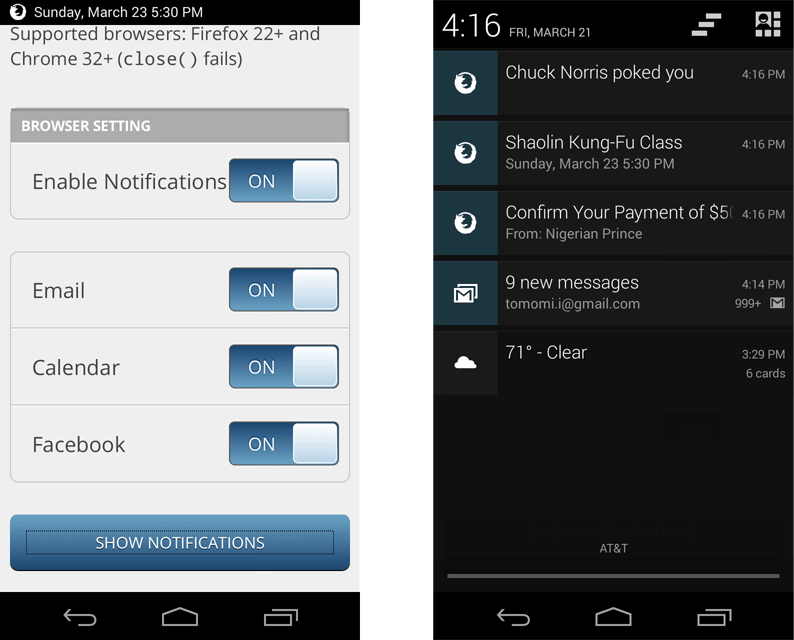Web Notifications Update

Two years ago, I wrote a demo and blogged about then-Chrome-only HTML5 notifications. A while ago, like, 8 Chrome versions ago, I’ve noticed the demo no longer worked, because the original specication I was using was deprecated for good.
Around the time, started by Apple first, each browser vendors had its own proprietary notifications API, then last year, they have decided to standardized specification.
I finally read the new specifications on W3C recently, and rewrote the demo using the standard API.
New and Simplified Specs
In the original demo, I implemented the notifications in webOS 3.0-style UX, which allowed a user to swipe to close the window. (Do you remember HP TouchPad, which was killed soon after the release and gone on fire-sale? I was a UI engineer for the beautiful dead platform.) However, this v2 demo no longer supports the swipable notifications UI because the simplified new Web Notifications spcification only allows text and icon, and external HTML (with JS) files are no longer permitted.
Demo
Check out the new demo: http://girliemac.com/html5-notifications-webOS-style (I keep the webOS system config look-and-feel!)
The simplified standard uses Notification object to represent each notification. (No webkit or moz vendor prefixes are required for the supported browsers.)
var notification = new Notification('YOLO!');
Request Permission

Notifications can only be displayed if the user has granted permission. Requesting the user agent to ask a user for permission is done as follows:
Notification.requestPermission(callback);
This process is done asynchronously, and the callback function is called when the user chooses a permission either default, granted, or denied.
Displaying Notifications
if (Notification.permission === 'granted') {
var n = new Notification('Meeting', {
body: 'March 21 3:30 PM',
icon: 'calendar.png'
});
}

Events
Notification fires show and close events during the lifecycle.
To close the notification window after 15 seconds:
n.onshow = function() {
setTimeout(n.close, 15000);
}
Supported Browsers
- Firefox 22+ (both desktop and mobile)
- Chrome 32+ (Desktop only)
- Safari 6+ on Mac 10.8+ (Damnit, I need to upgrade my Mac to test!)
As long as I tested, the web notifications API is disabled on Chrome for mobile, while Firefox does support the feature (however, it has a UI issue).
Known Problems
- Chrome for Android does not support the feature
- Firefox on Android does support, however, only one line (the last line) is displayed on the native notification bar on top. No extra UI or window from browser. (tested on Firefox 29. Bug filed #986785.)
- On Chrome (tested on 33),
close()method does not seem to work. Notification windows fails to close automatically. (Bug filed #355214).
Firefox on Android
Notifications appear in the native notification bar, one at a time, instead of popup windows from browser.
The problem is that if a notificatin contains more than one lines one messages (when both main text and body are set), only the last line (body) is displayed, instead of the main title, which I think makes more sense. When the notification bar is expanded by a user, both subject and body text are visible (See the screenshot below).
Also, custom icons aren’t shown either. The icon on the notification is always Firefox icon.

References
- W3C Web Notifications
- WHATWG Notifications AP
- Can I use Web Notifications?
- MDN Using Web Notifications
- Apple Safari Developer Library Sending Notifications
comments powered by
